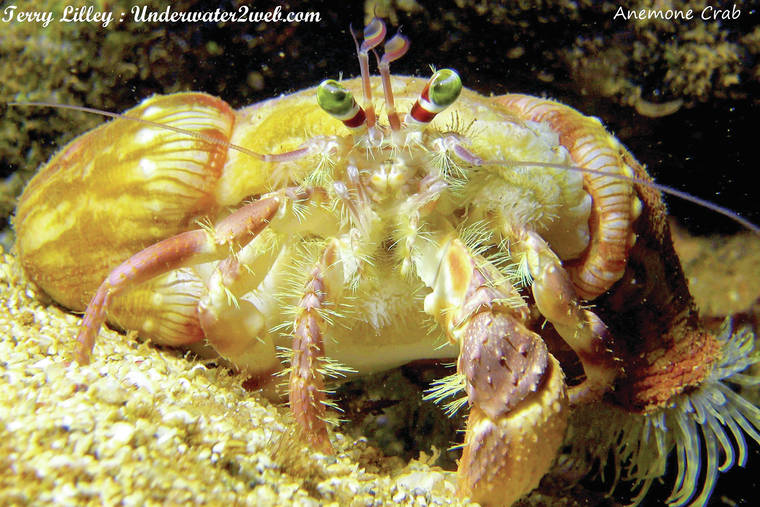This is by far one of the craziest creatures on our Hawaiian coral reefs. This three-inch-wide crab is a hermit crab because it does not grow its own shell, but finds empty shells to live in. This soft-bodied crab has large claws but a thin, long, soft abdomen, so it needs to find a hard snail shell to live in so it does not get eaten. The crab backs into the empty shell like a car backing into a garage, then holds onto the inside of the shell with tiny, specialized back legs. At will it can leave its shell and back into a new shell that may be larger as the crab grows.
This is by far one of the craziest creatures on our Hawaiian coral reefs. This three-inch-wide crab is a hermit crab because it does not grow its own shell, but finds empty shells to live in. This soft-bodied crab has large claws but a thin, long, soft abdomen, so it needs to find a hard snail shell to live in so it does not get eaten. The crab backs into the empty shell like a car backing into a garage, then holds onto the inside of the shell with tiny, specialized back legs. At will it can leave its shell and back into a new shell that may be larger as the crab grows.
I have seen these hermit crabs use lots of different kinds of empty shells, from tun shells to cone shells, and they sometimes fight over an empty shell to see who is going to move in. It only takes them a few seconds to back into a new shell and crawl away using its enlarged front legs.
What makes this strange-looking crab so unusual is what it decorates its home with. The anemone crab got its name because it grows sea anemones on top of its shell that it uses for protection, because the sea anemones have stinging tentacles and a predator fish may want to eat the crab but won’t do so because it would also have to eat the anemones on its back. So this very-smart crab not only finds a free new home to live in, it also borrows sea anemones to protect itself like bodyguards.
For many years I could not figure out how the anemone crab got the sea anemones to attach to the top of their shell. I knew the anemones did not just start growing on the shell because I have never seen a young anemone on the crabs’ shell. Only mature sea anemones were growing on the crabs’ homes. One day while diving I finally figured out how the crab collects the anemones. The small species of sea anemone the crab uses normally attach to the rocky reef, but if the base of the anemone is “tickled” in just the right way it will release from the reef. The crab tickles the base of the anemone until it lets go of the reef, then uses its claws to remove the anemone from the rocks and put it onto its own shell. After that the anemone goes everywhere the crab goes.
The anemone crabs have periscope eyes and are scavengers feeding on most dead animals on the reef. They are more active at night than in the day, but you can find them hiding under the rocks.
In the Reef Guardians Hawai‘i Coral Reef Kids Camp this summer I found one of these unusual crabs roaming around and picked it up to go show the students. By the time I reached the kids the crab had abandoned its shell and I just had an empty shell in my hands. We had to turn around and found the naked anemone crab crawling across the sand in a panic, and we put the empty shell back on the sea floor. The crab instantly crawled over to the shell, turned around and backed in, then scurried off across the reef.
One of the reasons it is good to leave empty sea shells out on the reef when you find them is because they will be the future homes of the hermit crabs.
See the jeweled anemone crab in action on the underwater educational web page at underwater2web and follow all of my underwater weekly Instagram post under my name at terry.lilley.
Aloha from under the surf.
•••
Terry Lilley, a marine biologist, lives in Hanalei. His websites include underwater-2web.com andgofundme.com/5urrm4zw.

Subscribe today for unlimited access.
Already a subscriber?
Login
Not ready to subscribe?
Register for limited access.
If you have a print subscription but require digital access,
activate your account.





